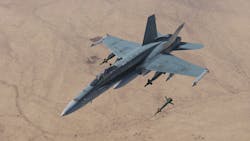Leidos to develop electronic warfare (EW) adaptive radar countermeasures software to protect F/A-18 aircraft
PATUXENT RIVER NAS, Md. – Electronic warfare (EW) experts at Leidos Inc. are developing ways to spoof adaptive radar, which uses digital technology to change its characteristics dynamically to adapt to changes in its environment.
Officials of the Naval Air Systems Command at Patuxent River Naval Air Station, Md., announced a $58.9 million order Thursday to Leidos in Reston, Va., to develop adaptive radar countermeasures hardware and software for the L3Harris AN/ALQ-214A EW system aboard Navy F/A-18 carrier-based jet fighter-bombers.
The Navy wants adaptive radar countermeasures capability for the AN/ALQ-214A to help F/A-18s survive in the presence of sophisticated enemy radar-guided surface-to-air missiles. Adaptive radar is being designed to counter the effects of EW countermeasures and other RF interference.
Leidos experts have been developing adaptive radar countermeasures technologies for at least the last eight years. The company was among several U.S. defense companies to win contracts in March 2013 for the Adaptive Radar Countermeasures (ARC) program of the U.S. Defense Advanced Research Projects Agency (DARPA) in Arlington, Va.
Related: BAE Systems to develop advanced electronic warfare (EW) to counter enemy programmable radar
In January 2016 Leidos won a $12.9 million follow-on contract for the DARPA ARC program. Leidos has been working with L3Harris Space & Airborne Systems segment in Clifton, N.J., on the ARC project. Leidos originally worked with Exelis Inc., which now is part of L3Harris.
In addition to Leidos, other DARPA ARC contractors include Vadum Inc. in Raleigh, N.C.; Helios Remote Sensing Systems Inc. in Rome, N.Y.; Michigan Tech Research Institute (MTRI) in Ann Arbor, Mich.; BAE Systems Electronic Systems in Merrimack, N.H.; and Systems and Technology Research (STR) in Woburn, Mass.
L3Harris has demonstrated Leidos software algorithms with an L3Harris EW hardware-in-the-loop test environment as an enhanced capability to electronically defend against emerging radar threats.
The goal of the DARPA ARC program has been to develop ways to counter adaptive radar threats quickly based on over-the-air observable signals.
Related: Navy continues buying radar-spoofing electronic warfare (EW) equipment from Mercury Systems
Today's airborne EW systems are proficient at identifying analog radar systems that operate on fixed frequencies, experts say. Once they identify a hostile radar system, EW aircraft can apply a preprogrammed countermeasure technique. Yet the job of identifying modern digitally programmable radar variants using agile waveforms is becoming more difficult. Leidos and the other ARC contractors worked to enable systems to generate effective countermeasures automatically against new, unknown, or ambiguous radar signals in near real-time.
Key challenges to countering adaptive radar are how to isolate signals clearly amid hostile, friendly, and neutral signals; figuring out the threat the signal poses; and jamming the signal. Modern enemy radar systems, however, are becoming digitally programmable with unknown behaviors and agile waveform, so identifying and jamming them is becoming increasingly difficult.
Leidos has developed processing techniques and algorithms to counter adaptive radar threats through real-time analysis of the threat's over-the-air observable properties and behaviors.
The ARC program developed a closed-loop system with signal analysis and characterization, countermeasure synthesis, and countermeasure effectiveness assessment. The system not only can learn automatically to counter new radar threats, but also will enable human operators to command and receive feedback from the system.
It was among DARPA's original goals for the ARC program to develop software algorithms for existing or planned EW systems, such as the AN/ALQ-214A on the F/A-18. DARPA kicked-off the ARC program in mid-2012.
On this order Leidos will do the work in Arlington, Va.; Clifton, N.J.; Goleta, Calif.; St. Louis; Raleigh, N.C.; and Huntsville, Ala., and should be finished by February 2024.
For more information contact Leidos online at www.leidos.com, L3Harris Space & Airborne Systems at www.l3harris.com/business-segments, or DARPA at www.darpa.mil/program/adaptive-radar-countermeasures.
About the Author
John Keller
Editor-in-Chief
John Keller is the Editor-in-Chief, Military & Aerospace Electronics Magazine--provides extensive coverage and analysis of enabling electronics and optoelectronic technologies in military, space and commercial aviation applications. John has been a member of the Military & Aerospace Electronics staff since 1989 and chief editor since 1995.
